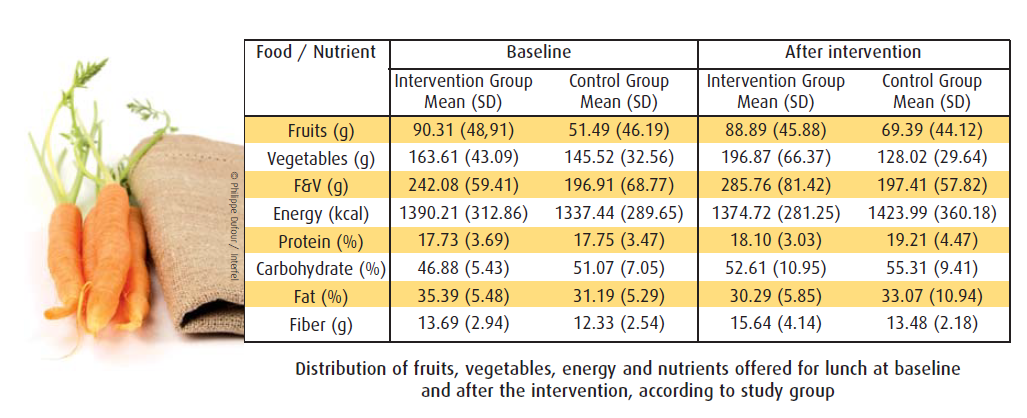Impact of an intervention on the availability and consumption of fruits and vegetables in the workplace
The workplace is considered a good setting for interventions aimed at promoting healthy diet, like the consumption of fruits and vegetable. The Worker Food Program (WFP) is a Brazilian Policy that encourages companies to offer subsidized meals to their employees. This paper describes the impact of an intervention on the availability and consumption of fruits and vegetables in a workplace cafeterias registered in the WFP in the city of São Paulo, Brazil.
INTERVENTION TO PROMOTE FRUITS AND VEGETABLES
The intervention was based on an ecological model for health promotion and was performed in four consecutive stages, with the participation of managers of cafeterias companies.
The first stage of the intervention consisted of a manual provided to the managers, containing information about the importance of a balanced diet to the workers wellbeing and performance and the key role of fruits and vegetables on health.
In the second stage, culinary workshops were run for cafeteria workers and those responsible for preparing companies meals (cooks and kitchen assistants). During the sessions, suggestions for recipes that incorporated fruits and vegetables were presented, along with guidance on the presentation and arrangement of meals.
In the third stage, educational materials were distributed at the workplace cafeteria with messages encouraging fruit and vegetable consumption. In addition, labeling information was provided at the point of choice (where the workers chose their food) to indicate healthy options. The last stage involved an educational approach, using posters to summarize the main points of the previous stages and Promote fruit and vegetable consumption.
To assess the impact of the intervention, the main outcome measure was the change in availability of fruits and vegetables served to each customer at lunch. An assessment was also made of the availability of energy, protein, carbohydrates, fat and fibre in the meals served to workers. Additionally, the study evaluated the consumption of fruits and vegetables at the workplace, asking about the amount of portions consumed at lunch. Data collection occurred at two points: at baseline and after the intervention (six months), and by involving a sample of twenty nine companies separated into two groups (intervention n=15 and control n=14).
INCREASED AVAILABILITY AND CONSUMPTION OF FRUITS AND VEGETABLES AFTER INTERVENTION
After the intervention the study found an average increase in the availability of fruits and vegetables of 49g in the intervention group, an increase of approximately 15%, whereas the results for the control group remained practically equal to baseline levels. During the follow-up period, the intervention group also reduced total fat and increased fibre consumption.
After the intervention, there was an increase in the consumption of fruits and vegetables by workers in the intervention group (from 104.85 to 123.03g), while no significant modification was observed in the control group. The multivariate analysis, determined by linear regression models, showed that there was an increase of 13.21g in the consumption of fruits and vegetables in the intervention group.
Results of this study, published recently in the Public Health Nutrition, show that the intervention increased the offer and consumption of fruits and mainly vegetables in the meals served by the companies, demonstrating that simple interventions like these are feasible and effective in the promotion of fruit and vegetable intake at the workplace.

References
Bandoni DH, Sarno F, Constante PC. Impact of an intervention on the availability and consumption of fruits and vegetables in the workplace. Public Health Nut
2011: 14, 975–981
